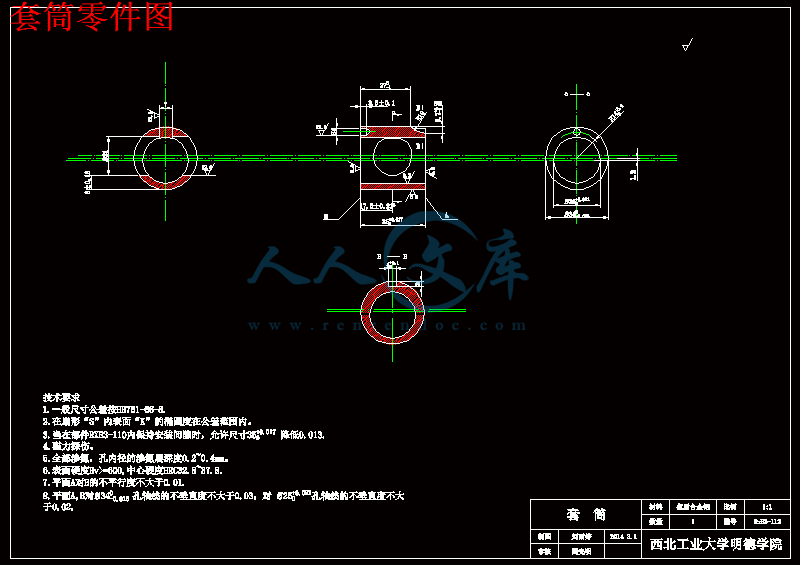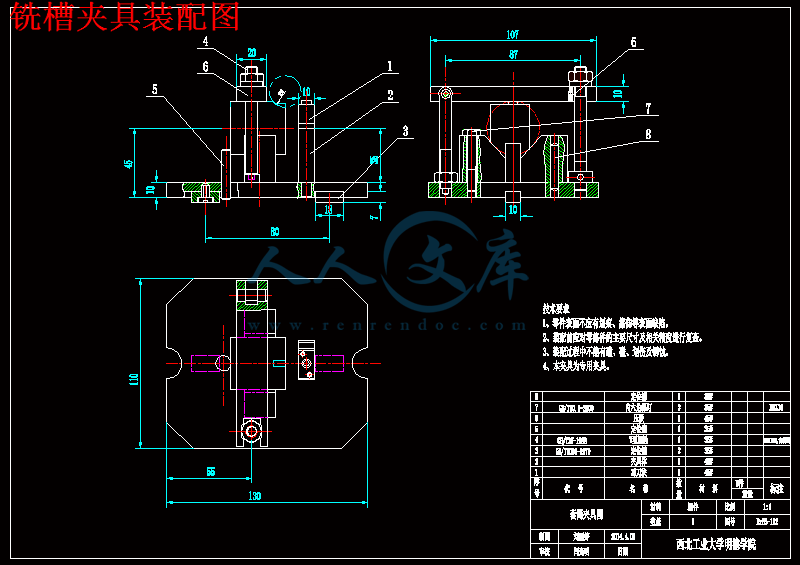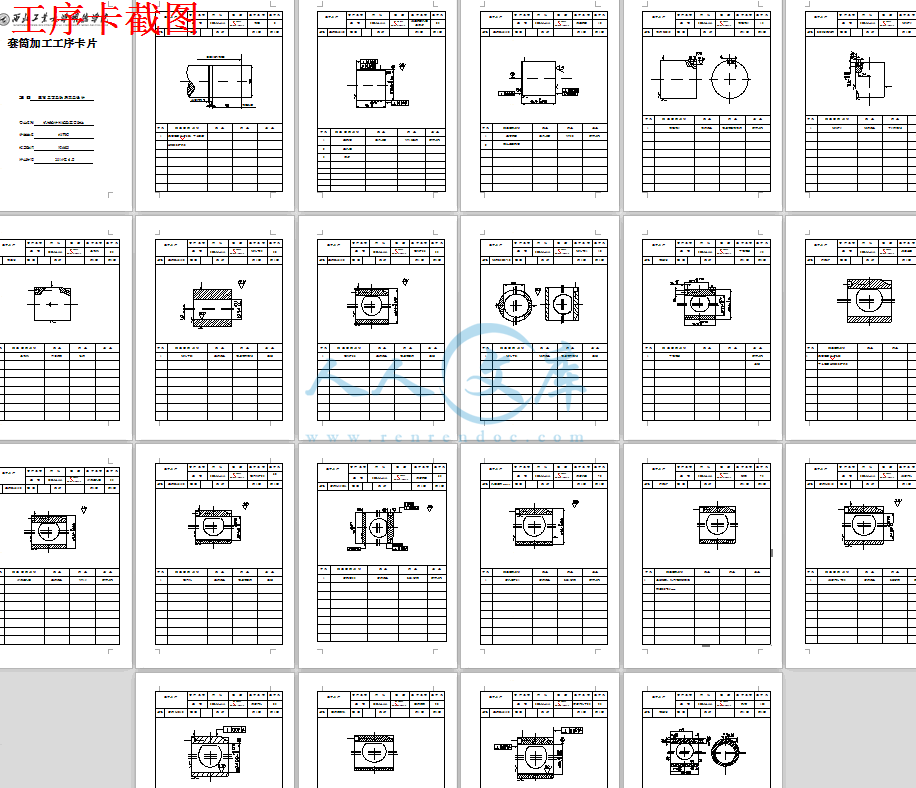摘 要
工艺学是研究机械加工工艺技术和夹具设计为主的技术学科,具有很强的实践性,要求学习过程中应紧密联系生产实践,同时它又具有很强的综合性。本次毕业设计研究的课题是套筒零件加工工艺编制及铣床夹具设计,主要内容如下:首先,对零件进行分析,根据零件图提出的具体加工要求,确定毛坯的制造形式和尺寸。第二步,进行基面的选择,确定加工过程中的粗基准和精基准。根据选好的基准,制定工艺路线方案,第三步,根据已经确定的工艺路线,选择加工设备及工艺装备,再确定每一工步的切削用量。在机械设计制造各行业的工艺过程中广泛应用着各种不同的,用以固定加工对象,使之占有正确位置,以便接受施工的一种工艺装备,通称为夹具。本次夹具设计则是设计铣套筒圆弧R10mm 的夹具。设计夹具先对原始资料进行分析,明确设计的要求和意图,然后提出具体的定位、夹紧、对刀方案和夹具体的一般结构。为保证设计的可靠性,还要对夹具的夹紧力和精度进行了分析。同时使设计基准与定位基准相重合,保证了槽侧面的加工精度与位置公差。然后确定夹具结构方案,然后开始切削力、夹紧力的计算和定位误差的分析。最后,把整个设计过程整理为设计说明书和图纸,至此整个设计基本完成。
关键词:套筒,加工工艺,铣床夹具
ABSTRACT
Technology is the technology research of mechanical processing technology and fixture design, has a strong practice, requirements should be closely combined with the production practice in the learning process, and it also has the very strong comprehensive. The graduation design topic is the preparation technology of the sleeve parts processing and milling fixture design, the main contents are as follows: firstly, the analysis of parts, according to the specific part drawing processing requirements, determine the manufacture of blank shape and size. The second step, the selection of base, determine the processing of crude and refined baseline benchmark. According to the chosen benchmark, creating process flow scheme, the third step, according to process routes have been identified, select the processing equipment and process equipment, then determine the amount of cutting each work step. In the process of mechanical design and manufacturing industries in a wide variety of applications, for processing a fixed object, so that possession of the correct position, to receive a construction techniques and equipment, known as the fixture. The jig design is the fixture design of arc milling sleeve R10mm. Fixture design first carries on the analysis to the original data, make clear of the design requirements and intentions, and then put forward specific positioning, clamping, clamping tool setting scheme and general structure of concrete. In order to ensure the design reliability, but also on the clamping force and precision was analyzed. At the same time the design standard and the locating datum coincide, ensure the machining precision and position tolerance groove side. Then determine the structure scheme of fixture, calculation and positioning error analysis and began cutting force, clamping force. Finally, the whole design process for the design specifications and drawings, thus the whole design is basically completed.
Keywords: sleeve, machining, milling fixture
目录
第一章 绪论1
第二章 套筒零件图分析3
2.1 套筒零件图的分析3
2.1.1 套筒结构特点3
2.1.2 套筒作用4
2.1.3 套筒工艺分析4
第三章 套筒工艺过程分析7
3.1确定毛坯7
3.1.1 毛坯选择7
3.1.2 绘制毛坯图8
3.2拟定工艺路线8
3.2.1 各表面加工方法8
3.2.2 定位基准的选择19
3.2.3 加工阶段的划分20
3.2.4 工序集中与分散21
3.2.5 热处理工序安排22
3.2.6 辅助工序的安排22
3.2.7 重要工序的分析22
3.3 加工余量的确定23
3.4 尺寸链计算24
第四章 铣床夹具设计26
4.1 定位装置的设计26
4.2夹紧装置的设计26
4.3绘制夹具总图26
4.4夹具操作简述27
4.5夹具精度校核27
第五章 结论29
参考文献30
致 谢31
毕业小结32
附 录34
第一章绪论
夹具:机械制造过程中用来固定加工对象,使之占有正确的位置,以接受施工或检测的装置。
铣床夹具:均安装在铣床工作台上,随机床工作台作进给运动。主要由定位装置、夹紧装置、夹具体、连接元件、对刀元件组成。铣削加工时,切削力较大,又是断续切削,振动较大,因此铣床夹具的夹紧力要求较大,夹具刚度、强度要求都比较高。本设计主要采用AutoCAD软件对套筒R10圆弧快速夹具设计.根据零件图的特点对套筒R10圆弧快速夹具进行设计,首先是确定套筒R10圆弧快速夹具的大致模样,夹具设计的几点要求是保证工件的加工精度、提高生产效率、工艺性能好、使用性能好、经济性好,夹紧可采用偏心轴夹紧,通过偏心轴旋转的不同偏心距来夹紧与松弛。设计好后,对夹具进行绘制。夹具设计其实也就是对加紧和定位的设计,只要夹紧设计定位好后,基本上夹具就完成了,但这只是基本,还要对他进行别的设计,比如首先保证夹具的安全性、工件的加工精度、提高生产效率、工艺性能好、使用性能好、经济性好,又比如可浮动、可联动、可增力、可自锁、快速装夹等等,这些都很重要,所以设计要从各方面不同的角度考虑夹具设计这个问题。
工艺规程:是指导施工的技术文件。一般包括以下内容:零件加工的工艺路线,各工序的具体加工内容,切削用量、工时定额以及所采用的设备和工艺装备等。




 川公网安备: 51019002004831号
川公网安备: 51019002004831号